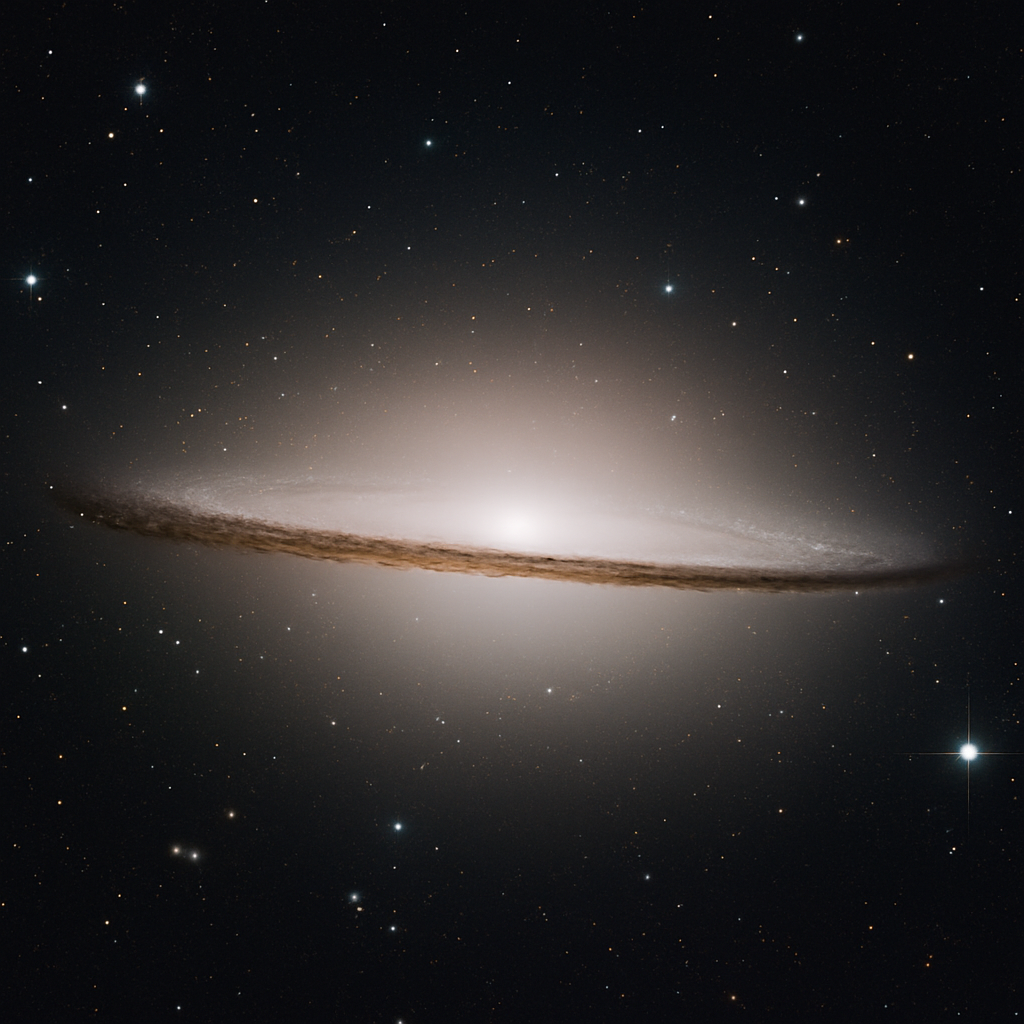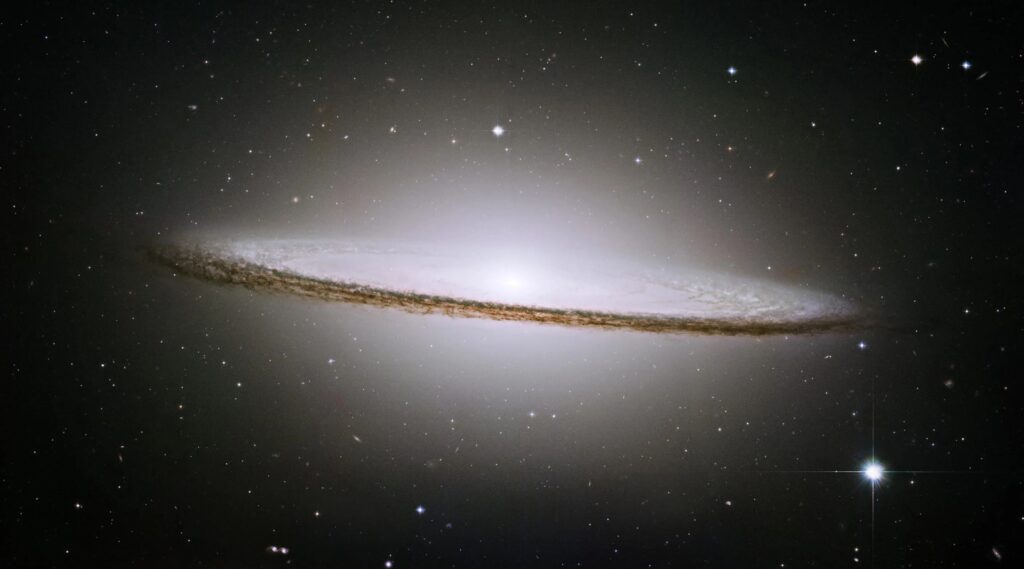
Introduction
As part of the 35th anniversary celebration of the ESA/Hubble collaboration, astronomers have released a newly enhanced image of one of the most iconic galaxies in the night sky: the Sombrero Galaxy. This captivating cosmic marvel has long been a fan-favorite, and the latest release offers a fresh, high-resolution look at the galaxy’s stunning structure, thanks to cutting-edge data and advanced image processing techniques.
Revisiting a Galactic Icon: The Sombrero Galaxy
The Sombrero Galaxy, formally known as Messier 104 (M104), lies approximately 30 million light-years away in the constellation Virgo. Its nickname stems from its unmistakable resemblance to the traditional Mexican hat, complete with a wide brim and a central bulge that gives it a distinctive silhouette. Observed nearly edge-on, the galaxy appears as a brilliant white core surrounded by a thin, dark band of interstellar dust.
What sets the Sombrero Galaxy apart from other celestial objects is its viewing angle — just six degrees off from edge-on — providing a rare, detailed look at its structure. This orientation offers a unique visual experience, making the dust lanes appear even more pronounced, almost like Saturn’s rings on a galactic scale.
A New Image with Unprecedented Detail
ESA/Hubble’s newly released image of the Sombrero Galaxy is not just a rehash of older views. This version incorporates updated observational data and the latest image processing techniques to uncover subtle features never seen before. The image was crafted from a mosaic of several Hubble exposures to encompass the entire galaxy, which is too large to fit into a single frame of the telescope’s narrow field of view.
Thanks to these advancements, astronomers have now revealed:
- Finer structural details in the galactic disk
- Intricate dust lanes wrapping around the core
- Enhanced visibility of background galaxies and stars
These improvements provide scientists and space enthusiasts with a clearer understanding of this enigmatic galaxy’s physical characteristics and history.
Unraveling the Mysteries of the Sombrero Galaxy
Despite its prominence in astronomical imagery, the Sombrero Galaxy remains something of a mystery to researchers. One key question concerns its classification: Is it a spiral galaxy or an elliptical one?
- Its thin disk and prominent dust lanes resemble a spiral galaxy, like the Milky Way.
- Its large, spherical central bulge and extended halo are more characteristic of elliptical galaxies.
This strange blend makes the Sombrero Galaxy a rare hybrid, challenging traditional classifications. Some astronomers believe it might have originated from a massive galactic merger billions of years ago, leading to its peculiar form. Hubble’s sensitive instruments have provided key insights to support this theory.
Measuring Metal-Rich Stars in the Halo
One of the most intriguing discoveries from the latest research on the Sombrero Galaxy involves its halo — a vast, faint cloud of stars surrounding the galactic disk. Using Hubble, researchers measured the metallicity (the abundance of elements heavier than helium) in the stars of the galaxy’s halo.
What they found was unexpected: the stars in the Sombrero’s halo were extremely metal-rich. This is unusual because halo stars in most galaxies tend to be older and have lower metallicities.
This high metal content could be a smoking gun indicating that the Sombrero Galaxy once merged with another massive galaxy. Such a collision would have enriched the halo with younger, metal-rich stars and altered the structure of the host galaxy — possibly giving rise to the striking features we see today.
A Calm Giant in the Cosmos
Despite its dramatic appearance and massive central black hole — estimated at around nine billion solar masses, more than 2,000 times the mass of the Milky Way’s central black hole — the Sombrero Galaxy is surprisingly quiet.
- Star formation activity is relatively low, with less than one solar mass of gas being converted into stars each year.
- Its active galactic nucleus appears calm, showing few signs of the violent outbursts typical in some other galaxies with similarly massive black holes.
This tranquility makes the Sombrero Galaxy a fascinating subject for studying the later stages of galactic evolution, where star formation slows and the structure settles.
A Popular Target for Amateur Astronomers
The Sombrero Galaxy has long been a favorite among amateur astronomers and astrophotographers. While it’s too faint to be seen with the naked eye, it is easily visible through small telescopes under dark skies. From Earth, the galaxy appears about one-third the diameter of the full Moon, making it a manageable target for backyard stargazing.
In fact, many early images of the galaxy were captured by amateur astronomers, drawn to its distinctive shape and ethereal beauty. Over the years, space telescopes like Hubble and, more recently, the James Webb Space Telescope (JWST), have built upon these initial observations with far greater clarity and depth.
Hubble and Webb: A Powerful Duo
While the latest image of the Sombrero Galaxy was captured by Hubble, the galaxy has also recently been studied by the NASA/ESA/CSA James Webb Space Telescope. In November 2024, Webb provided infrared imagery that offered an entirely different perspective, penetrating the dusty disk to observe star-forming regions and cooler structures invisible to optical telescopes like Hubble.
Together, Hubble and Webb offer complementary views of celestial targets. Hubble excels at high-resolution visible-light imaging, revealing fine structural details, while Webb peers into the cooler, dust-shrouded regions of the universe in infrared light. These two observatories together are revolutionizing our understanding of galactic dynamics and evolution.
Celebrating 35 Years of Hubble
The release of this new image is part of ESA/Hubble’s 35th anniversary celebration, marking over three decades of groundbreaking science and awe-inspiring imagery. Since its launch in 1990, the Hubble Space Telescope has:
- Captured over 1.5 million observations of more than 50,000 celestial objects
- Helped measure the age and expansion rate of the universe
- Played a pivotal role in the discovery of dark energy
- Unveiled the birth and death of stars in breathtaking detail
And now, with its latest revisit of the Sombrero Galaxy, Hubble continues to captivate and inform both scientists and the public.
Conclusion: The Sombrero Galaxy Remains a Cosmic Treasure

The newly processed image of the Sombrero Galaxy underscores why this celestial object continues to fascinate astronomers and stargazers alike. Its distinctive shape, hybrid features, and mysterious history make it a compelling subject of study.
With ongoing observations from both Hubble and Webb, researchers hope to further unravel the secrets of this galactic oddity — from its past mergers to the nature of its central black hole and surrounding halo. As science advances and technology improves, the Sombrero Galaxy will undoubtedly remain one of the most iconic and intriguing galaxies in our cosmic neighborhood.
2 thoughts on “Hubble Reveals Stunning New View of the Sombrero Galaxy”